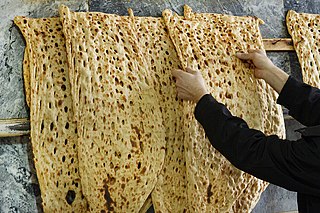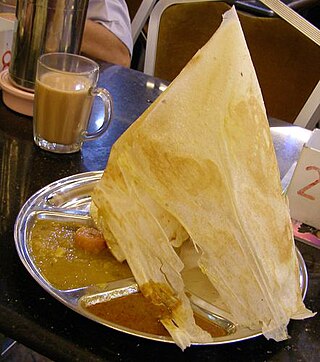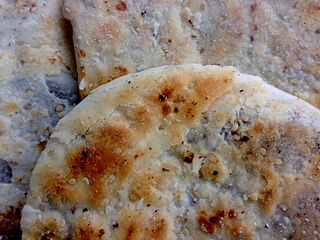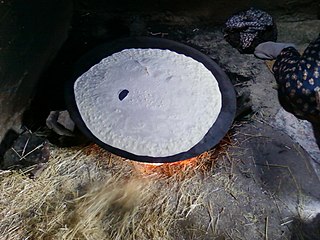Related Research Articles

Roti is a round flatbread originating from the Indian subcontinent. It is commonly consumed in many South Asian, Southeast Asian, Caribbean, and Southeast African countries.

Ful medames, or simply fūl, is a stew of cooked fava beans served with olive oil, cumin, and optionally with chopped parsley, garlic, onion, lemon juice, chili pepper and other vegetables, herbs, and spices. Ful medames is traditionally made in and served out of a large metal jug. It is notably a staple food in Egypt and is considered a national dish, especially in the northern cities of Cairo and Gizah. Fava beans can sometimes be also found in other cuisines in the Middle East, and Africa, though cooked differently.

Sangak or nân-e sangak is a plain, rectangular or triangular Iranian whole wheat leavened flatbread.

A flatbread is bread made usually with flour; water, milk, yogurt, or other liquid; and salt, and then thoroughly rolled into flattened dough. Many flatbreads are unleavened, although some are leavened, such as pita bread.

Flatbrød is a traditional Norwegian unleavened bread which is usually eaten with fish, salted meats and soups. Originally it was the staple food of Norwegian farmers, shepherds and peasants. Flat bread is dry and free from water so it is possible to store it for a long period of time.

Gored gored is a raw beef dish eaten in Ethiopia. Whereas kitfo is minced beef marinated in spices and clarified butter, gored gored is cubed and left unmarinated. Like kitfo, it is widely popular and considered a national dish. It is often served with mitmita and awaze.

Roti tissue, roti tisu, or tisu prata is a sweet flatbread often sold at Mamak stalls in Malaysia and Singapore. It is also known as "roti helikopter". Roti tisu is a thinner and crispier version of the traditional roti canai/ prata. It is as thin as a piece of 40–50 cm round-shaped tissue.

Lahoh, is a spongy, flat pancake-like bread. It is a type of flat bread eaten regularly in Somalia, Djibouti, Ethiopia and Yemen. Yemenite Jewish immigrants popularized the dish in Israel. It is called Canjeero/Canjeelo in southern Somalia and Djibouti, and also called Laxoox/Lahoh in northern Somalia, respectively.

Khubz mulawah, mulawah, or rashush is a flatbread that is baked in a traditional tannur in Yemeni cuisine. A similar bread, malawach, has been brought to Israel by Yemenite Jews.

Somali cuisine was influenced by many different countries mainly due to trade, but traditionally also varies from region to region due to the expansive landmass Somalis inhabit. It is the product of Somalia's tradition of trade and commerce. Some notable Somali specialties include kimis / sabaayad, canjeero / laxoox, xalwo (halwa), sambuusa (samosa), bariis iskukaris, and muqmad / oodkac.

Maluj or Malooga is a leavened Yemeni flatbread eaten with bean dishes, scrambled eggs, spiced buttermilk, and many other Yemeni savory dishes.

Saltah is a traditional Yemeni dish. Saltah is considered to be the national dish of Yemen. In the Ottoman Empire, saltah was used as a charitable food and was made with leftover food that was donated by the wealthy or the mosques. It is widely eaten in northern parts of the country. It is mainly served for lunch. The base is a brown meat stew called maraq, a dollop of fenugreek froth, and sahawiq. Rice, potatoes, scrambled eggs, and vegetables are common additions to saltah. It is eaten traditionally with khubz mulawah, a Yemeni flatbread used as a utensil to scoop up the dish.

Tajik cuisine is a traditional cuisine of Tajikistan, and has much in common with Russian, Afghan, Iranian and Uzbek cuisines. Plov (pilaf), also called osh, is the national dish in Tajikistan, as in other countries in the region. Green tea is the national drink.
A hoggan or hogen is a type of flatbread containing pieces of pork, and often root vegetables, apple also becoming a popular addition, historically eaten by Cornish miners and labours in the eighteenth and nineteenth centuries. Any food eaten by miners had to be tough to withstand the harsh conditions of the mines, and hoggans were said by one mining captain to be 'hard as street tiles'.

Bammy is a traditional Jamaican cassava flatbread descended from the simple flatbread eaten by the Arawaks, Jamaica's original inhabitants. Today, it is produced in many rural communities and sold in stores and by street vendors in Jamaica and abroad.

Podpłomyk, known in Old Polish as wychopień or wychopieniek, is the oldest known Slavic form of bread, in the form of a small flatbread baked on an open fire. It has been preserved to the modern day as a part of Polish cuisine.

Borlengo, also called burlengo or zampanelle, is an Italian thin flatbread. Originally a food eaten by the poor and made only with flour and water, it now also usually includes salt and optionally eggs, and is often made outside in a frying pan the size of a cartwheel. These are then rubbed with a mixture that can contain rosemary, garlic, salt pork, olive oil, or what is called cunza, sauteed minced pancetta and sausage, folded into quarters and sprinkled with Parmesan.

A piaya is a muscovado-filled unleavened flatbread from the Philippines especially common in Negros Occidental where it is a popular delicacy. It is made by filling dough with a mixture of muscovado and water. The filled dough is then flattened with a rolling pin, sprinkled with sesame seeds and baked on a griddle. Piaya is best eaten warm.
Xidoufen (稀豆粉) is a Chinese soup popular in Yunnan province that is made of boiled pea meal, often flavoured with crushed garlic, ginger, coriander, spring onion, dry chilli flakes and Sichuan pepper oil. It is often eaten with deep fried youtiao or Chinese flatbreads, particularly cong you bing.

Saj bread or tava bread is unleavened flatbread in Middle Eastern and South Asian cuisines baked on a metal griddle, called saj in Arabic and tava in the Indian subcontinent.